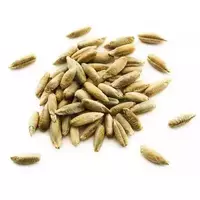Rye grains

Until recently, rye was rightly considered the main agricultural crop that prevails in the diet of peasants, but today the cultivation of this plant has largely decreased not only in our country, but also around the world.
Rye belongs to annual herbaceous plants that belong to the cereal family. Long linear leaves grow on the straight hollow stem, which are covered with thin hairs. This contributes to the good drought resistance of the plant, as well as the ability to grow well on light sandy soils.
The inflorescence of the rye flaunts at the top of the stem. It is a complex drooping spike that is covered with linear awl-shaped scales. It is under them that the fruits of the plant are contained - rye grains in the form of oval-oblong grains with a wrinkled surface, the color of which directly depends on the variety. The leading rye producing countries today are Russia, Poland and Germany.
Interestingly, experts have not yet come to a consensus regarding the homeland and origin of the rye. So, some scientists claim that there has been a cultivation of wild crops of cereals, while others prove the opposite: they say that wild rye does not exist in nature.
Meanwhile, respected Professor Batalin assures that rye is an cultivated plant. After a thorough study of the southern species of this plant, as well as the composition of rye grains, the scientist noticed a coincidence: this type of grain, after mowing, releases young shoots. In the same way, its relative Secale anatolicum, a perennial wild culture growing in Turkmenistan, does. However, one thing remains clear - the truth about the origin of this plant has been lost for centuries.
For the food industry, rye grains play a very important role: rye flour is made from them, which later goes to bake bread. In addition, this product is needed for the production of malt extract - a substance without which it is not impossible to make kvass, beer and some confectionery products.
However, the extensive application of rye grains and the plant as a whole is not limited to this. Since time immemorial, it has been known that this plant is an excellent orderly of the earth, as it helps to get rid of pests and weeds, and also gives the earth a "break" from vegetable and berry plantings. Today, winter rye varieties are quite often used in gardening and gardening today as a green natural fertilizer.
Composition of rye grains
The composition of rye grains is quite complex and multifaceted. Most of all, this product contains carbohydrates along with some water, proteins, fats, ash and dietary fiber. In addition, rye is rich in vitamins, macro- and trace elements.
rye grains 283 kCal
Energy value of rye grains (Ratio of proteins, fats, carbohydrates - ju):
Proteins: 9.9 g (~ 40 kCal)
Fats: 2.2 g (~ 20 kCal)
Carbohydrates: 55.8 g (~ 223 kCal)
Energy ratio (b | y): 14% | 7% | 79%
 Español
Español Français
Français Português
Português Русский
Русский 简体中文
简体中文 繁體中文
繁體中文 日本語
日本語 한국어
한국어 العربية
العربية Türkçe
Türkçe Қазақ
Қазақ Deutsch
Deutsch Italiano
Italiano Українська
Українська
